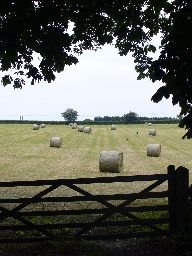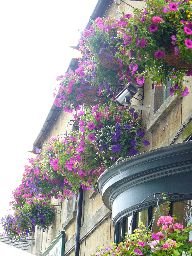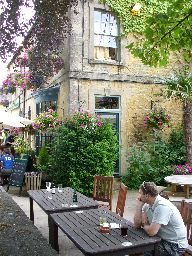
West of Oxford lies a picturesque series of hills known as the Cotswolds. The area is characterised by numerous quaint towns and villages built from local Cotswold stone (a yellow-gold limestone). It's an easy day trip from London - less than two hours drive. Today Garry and I decided to join the Summer tourist throng and visit the areas more famous sights.
It's difficult to describe the natural beauty of the Cotswolds. The entire area is criss-crossed by narrow, meandering lanes, framed on either side by waist-high summer grass and dry-stone wall fences. Around each corner another stunning country vista presents itself. Sheep in a meadow. Cows under a tree. Birds in the hedgerow. Ducks and their young in a stream. Haybales resting in a fresh-cut field.
The region grew wealthy on the wool trade between 1400 and 1600. It was this wealth that afforded the building of so many stone villages and manors. However the rise of foreign trade in 1700 sent the area into gradual decline. Many of the buildings and villages were all but abandoned until the late 20th Century when modern gentrification took hold.

We started our day by turning off the A40 to Cheltenham and entering the rustic village of Minster Lowell. This proved to be an ideal place to practice our road navigation skills. The Cotswolds consists of many single country laneways where an occasional small, simple white road sign is the only reference point. Minster Lowell sits on the banks of a gentle stream accessed by crossing a narrow stone arch bridge. Off in the distance we could see the locals playing an afternoon of cricket.
Minster Lowell was certainly pretty, as was the next village, Leafield, with its central village green, and the next village, Shipton-under-Wychwood. In fact, almost every village we came across all day was a perfect calendar scene. From Shipton we traveled south into Burford. The steeply sloping main street of Burford is oft-cited as the perfect shopping precedent for local arts and crafts. When we arrived the street was filled with traffic and parking was in short supply. We decided to continue south to Bibury rather than search for a place to leave the car.

Bibury was magic. William Morris once called it "the most beautiful village in England". It's renown for Arlington Row, a picture-postcard group of weaver cottages near the River Coln (pictured above). The row was originally a timber framed hall for storing the Bishop of Worcester's wool. However, in the 17th Century the hall was converted into cottages. Today, we had cottage row to ourselves with barely a tourist in sight.
While the cottages were stunning, I was more in awe of several sights nearby. It's hard to know what to describe first. For example there was the river filled with ducks and their brood of cheeky ducklings. Across the road, genuine cottage gardens were ablaze with summer flowers. Further upstream, a old stone bridge crossed over to a stone inn covered in verdant summer ivy. Finally, an old mill stood nearby, its stream filled with large, active trout.

We dropped into the mill for lunch, but the chef was having a bad day. "I'm sorry," said the woman behind the counter, " but we're not taking food orders at the moment. The chef has too many other orders to fill." We looked around the small room filled largely with empty tables and wondered just how good the chef really was. We quickly took our leave and drove north to Bourton-on-the-Water seeking a more reliable source of food.

Bourton-on-the-Water is often called the 'Venice of the Cotswolds" after all the little stone bridges that cross the river flowing through town. I'd prefer to call it the 'Disneyland of the Cotswolds'. The village is picture perfect, a little too perfect. While the scene was pretty, everything looked a little too clean and felt as if it had been carefully crafted to resemble the real thing.

Worse still the place was jammed with tourists, children and tour buses. The noise of so many people drowned out natural sounds, a marked contrast to every other Cotswolds village where silence and serenity were the norm. However, Garry was hungry so we stopped at a flower-decked stone pub by the river and ordered a late lunch. A burger for Garry and traditional English Fish and Chips for me.
From Bourton we traveled west to Lower Slaughter, another river-side village, but this time devoid of tourists and gift shops. The name Slaughter comes from the old name for a stream, or Slough, rather than referring to any scene of death and destruction. The river was peaceful with barely a person in sight. St Marys Church and the red-brick mill were exactly as the tourist books describe them. Memorable! Upper Slaughter was next. Yet another quiet, pretty stone village. Likewise, the Swells.
We eventually found ourselves turning off B4077 into Stanway, which sits at the bottom of an escarpment marking the western fringe of the Cotswolds Hills. Stanway was spectacular, with tiny winding laneways that zig-zagged their way through the village. However, nothing prepared us for the next few villages. Stanton was incredible. Narrow streets lined by grass banks and rows of yellow brick homes. Cricket on the lawn. Flowers in every window. A pretty little village green with a local war memorial.

From Stanton we drove on to Broadway. This is a relatively large town, still built from stone. It too had a stunning high street filled with ivy-covered hotels, thatched cottage shops and another memorable church. However, by this time, we'd seen so many stunning villages, the impact was wearing thin. We did spot a grand old hotel, The Lygon Arms, which looks like the perfect place for a long, leisurely weekend in the country. I think we might be back!

Our final stop in the Cotswolds was Broadway Tower, a 55-foot high stone 'folly' tower, that sits atop the escapement looking down over Broadway and its surrounding counties. It sits 1,024 feet above sea-level, marking one of the highest points in the area. It was designed to resemble a mock castle by James Wyatt, and built for Lady Coventry in 1797.
The hill upon which the tower was built was a "beacon" hill, upon which beacons were lit for special occasions. Lady Coventry wondered if a beacon on this hill could be seen from her house in Worcester. As you'd naturally expect, she sponsored the construction of a folly to find out. The beacon could be seen clearly. Today, we saw little more than sheep quietly grazing in its shadow.

From the tower we turned south again, taking the A44 south towards Oxford and then on to London. Our brief Cotswolds tour had covered more than 100 miles, taking us through some of England's most picturesque villages. The only low point was listening on the radio as Australia lost its world cup game against Brazil, 2-0. Otherwise, a truly wonderful day out.





No comments:
Post a Comment